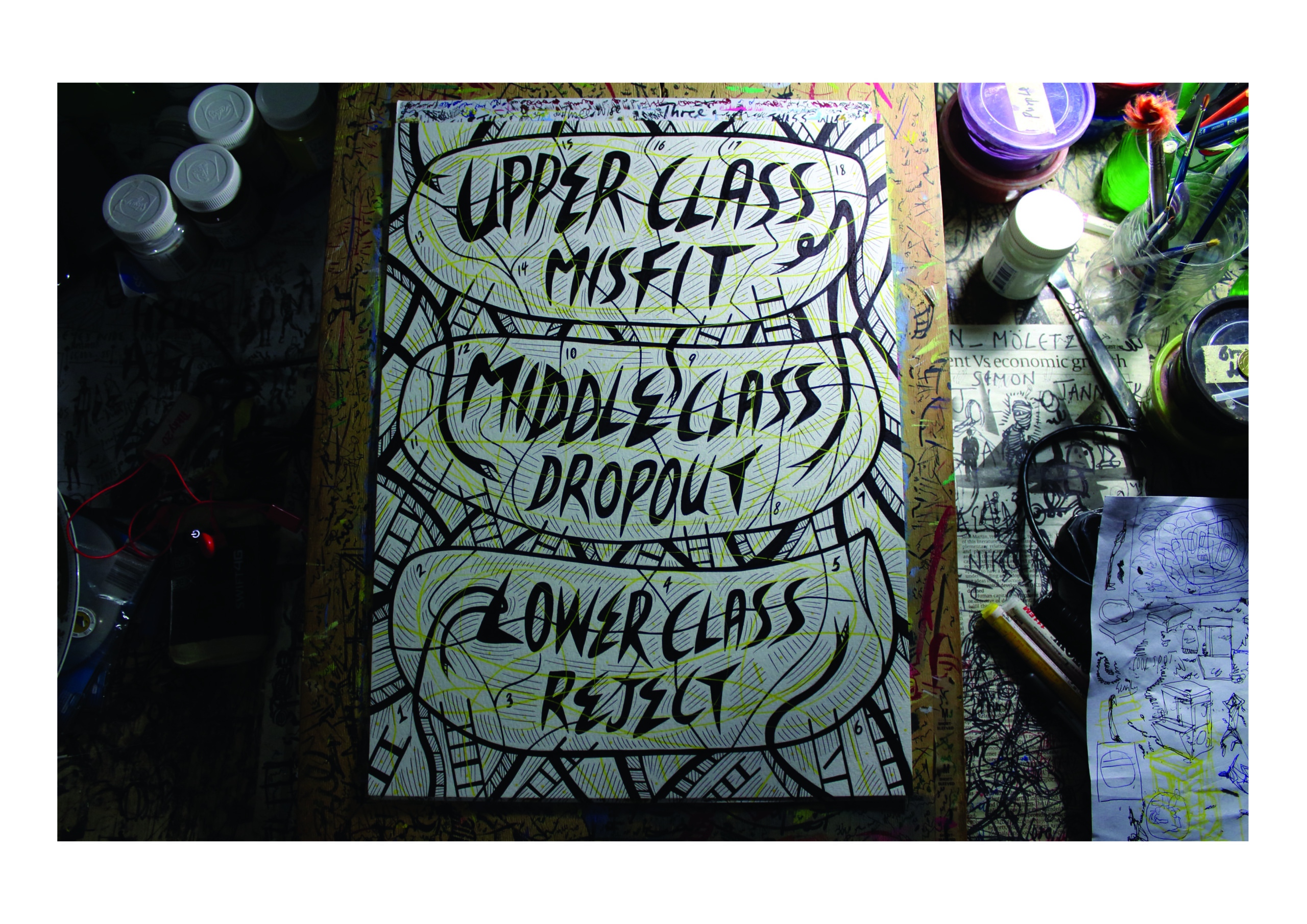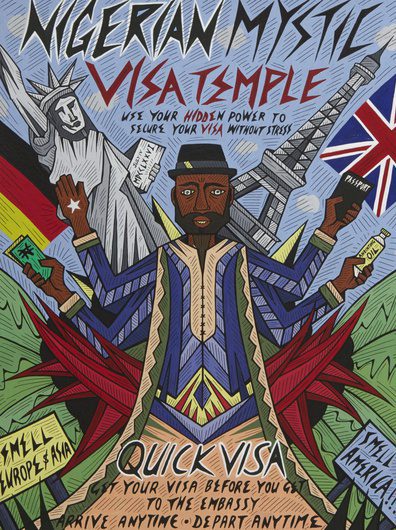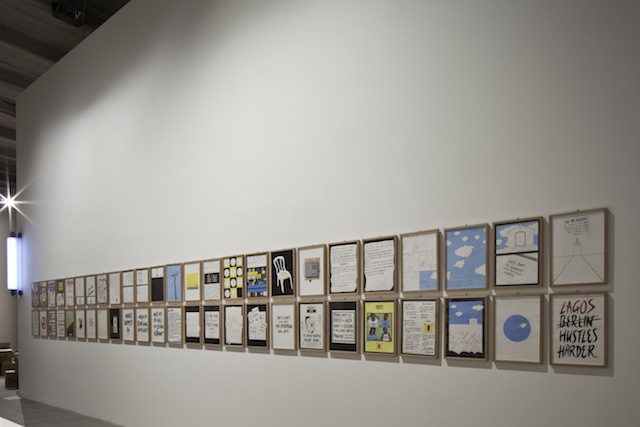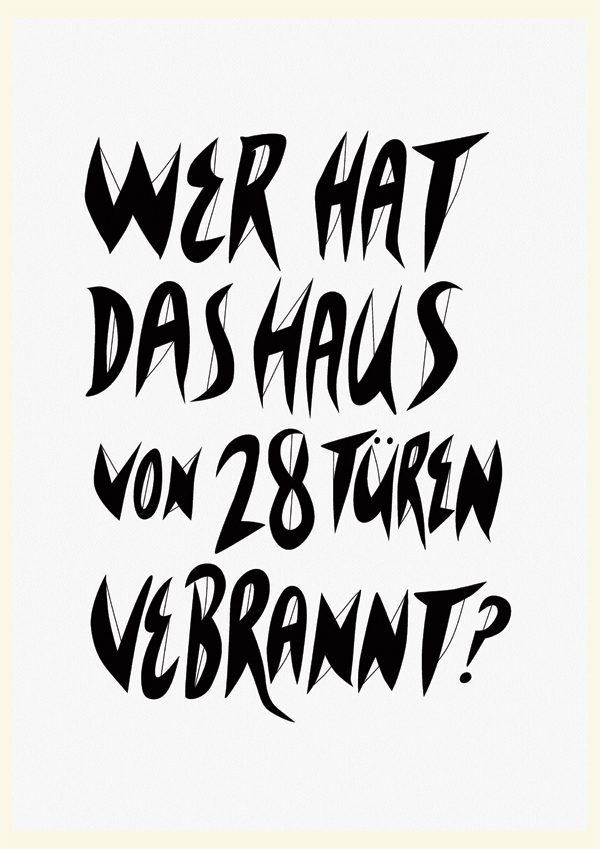C& s’entretient avec l’artiste Karo Akpokiere autour de son attachement au graphisme et du passage des frontières.

Karo Akpokiere, Classless, 2015 © the artist
C& : Votre enfance s’est-elle déroulée dans un contexte artistique ?
Karo Akpokiere : J’ai beaucoup dessiné en grandissant et grâce à mes parents, j’ai été en contact avec toute une série de livres qui ont nourri mon attirance vers le dessin et ma capacité à rêver.
C& : Surtout des bandes dessinées ?
KA : J’avais accès à divers livres illustrés tout comme à des bandes dessinées. Il y avait aussi des BD historiques consacrées la plupart du temps à la Première et à la Deuxième Guerre mondiale. Les BD de fiction plutôt liées à la vie quotidienne et celles mettant en scène des super héros faisaient partie de mes lectures. L’un dans l’autre, j’ai le souvenir de beaucoup de temps passé à dessiner, lire et regarder la télévision. Grandir à Lagos dans les années 80, c’était une période vraiment intéressante, durant laquelle on trouvait dans les médias un bon équilibre entre des contenus régionaux et internationaux de qualité. Et c’est cet équilibre qui m’a permis de développer une saine appréciation des cultures différentes tout comme de la mienne. L’une n’était pas nécessairement meilleure que l’autre. Le design graphique, les livres, les motifs, les dessins humoristiques etc. ont joué un rôle plus important que les visites de musées ou de galeries d’art dans la formation de mon identité visuelle et de mon sens de ce qu’est l’art et de ce à quoi il peut servir.
C& : Comment avez-vous décidé de devenir artiste ?
KA : Au départ je voulais faire des études scientifiques mais plus tard j’ai pris conscience du fait que l’art était ma vocation. C’est à ce moment que je me suis demandé comment entrer dans une école d’art ; pendant cette période transitoire, je me suis constitué un dossier. Ce qui me fascinait alors, c’était d’inventer des modèles de chaussures et j’espérais travailler un jour dans cette branche – je dessinais alors tous les jours du matin jusqu’au soir. En gros, c’est cette aspiration qui m’a aidé à intégrer une école d’art et à développer un intérêt profond pour le dessin et le design graphique. Lorsque j’étais à l’école d’art, mes parents m’avaient offert un livre sur la création de t-shirts qui s’appelait graphismes t-shirts 100% coton, dans lequel figuraient des designers tout comme des artistes utilisant le t-shirt pour faire passer un certain nombre de messages de nature personnelle, humoristique ou politique. En prenant le temps de m’informer sur tous les artistes représentés dans ce livre, je suis tombé sur des peintres qui créaient des chaussures, des designers graphiques qui faisaient des meubles et ainsi de suite. Cette constatation a eu un impact énorme sur moi car elle m’a fait prendre conscience que je pourrais travailler en ayant recours à n’importe quel support et sans tenir compte de quelconques frontières. Auparavant, j’avais pour idée fixe de créer des chaussures ; ce livre m’a aidé à élargir ma vision de l’avenir.

Karo Akpokiere, Nigerian Visa Mystic Empire,
2013. Gouache and ink on 300gms watercolour paper. 16″ x 12″ © the artist
C& : Vous qualifieriez-vous de designer graphique ?
KA : Oui, en cela que j’ai étudié le design graphique. Oui, parce que cela me permet parfois d’expliquer mon travail facilement. Quelquefois il s’agit d’émettre des considérations pratiques au cours d’une discussion et de faire avancer les choses. Cependant, il m’importe plus de consacrer mon attention aux choses qui m’intéressent profondément, et de créer à partir d’un centre d’intérêt, plutôt que de me soucier d’appellations et de l’impact qu’ont ces appellations sur la manière dont est perçu mon travail. Ce qui m’importe, c’est de pouvoir faire ce que je veux, quoi que ce soit. Je ne suis pas perturbé lorsqu’on me considère comme un designer graphique, parce que je sais à quelles fins le design peut être utilisé, au-delà de l’aspect commercial. Le design graphique représente la vie d’une manière qui fait fusionner réalité et fiction bien que cela ait lieu dans un contexte lié au quotidien ; il est particulièrement présent dans l’espace public où visibilité et accessibilité ne sont pas vraiment le problème. Il peut être commercial ou non, politique ou non sans prétention. Le fait d’accorder de l’attention au design graphique est une façon de connaître les idées qui prévalent dans un espace particulier à un moment particulier. Cela propose une approche de la ville qui permet d’en saisir le mode de fonctionnement.
C& : Vous vivez entre Lagos et Berlin depuis 2013, qu’avez-vous remarqué en termes de design graphique dans ces deux contextes ?
KA : Je crois que les différences entre Lagos et Berlin sont plus nombreuses que les similitudes. Par exemple, si vous vous concentrez sur le contenu du design graphique ici à Berlin, vous voyez une ville fascinée par les arts et la culture. Les arts graphiques d’orientation politique sont également très visibles. À Lagos, on a principalement affaire à du travail de graphisme traduisant des pratiques et croyances religieuses. Pour moi, l’art graphique a toujours un fondement contextuel.

Karo Akpokiere, Zwischen Lagos und Berlin, 2015, cinquanta disegni, gouache, penna e matita su carta, 56th International Art Exhibition – la Biennale di Venezia, All the World’s Futures. Photo by Alessandra Chemollo. Courtesy: la Biennale di Venezia
C& : vous participez cette année à la 56e Biennale de Venise, l’une de vos pièces exposées est assez impressionnante surtout lorsque l’on connait le contexte berlinois. Elle s’appelle « Wer hat das Haus von 28 Türen verbrannt ? » (Qui a incendié la maison des 28 portes?), une référence au projet artistique sur l’immigration qui a brûlé au mois de mars passé à Berlin. Parlez-nous en un peu.
KA : de retour à Berlin en juin 2014, je suis tombé sur une manifestation de soutien aux migrants à l’Oranienplatz à Kreuzberg. Jusqu’alors, je n’avais pas d’opinion sur les problèmes d’immigration en Allemagne. J’ai vu les banderoles portant des inscriptions en anglais « You can’t evict a movement », « No borders, no nations », « Stop deportation » Après être resté sur place un moment, j’ai assez vite compris de quoi il retournait par le biais des banderoles et des discours. Après cela, ma curiosité a été éveillée sur ce qui se passait ici à Berlin. À Lagos, personne ne parle de la question des réfugiés, comme si c’était un secret bien gardé. Ce n’est pas l’Allemagne qui est présentée au reste du monde. J’ai été choqué en en apprenant plus sur les demandeurs d’asile et leur situation. J’ai fait la connaissance de plusieurs personnes comme par exemple Paula Bulling, qui agit sur le plan politique et a fait un roman graphique Im Lande der Frühaufsteher parlant de la situation dans la ville de Halle. J’ai pris conscience (après m’être entretenu avec l’un des réfugiés) de la signification de la Maison des 28 portes lorsque je me suis rendu sur l’Orianenplatz en décembre 2014 pour participer à une manifestation qui n’a malheureusement pas eu lieu. Cette installation a valeur de monument pour garder le souvenir des réfugiés ayant perdu la vie lors de leur tentative de rejoindre l’Europe, et des conditions dans lesquelles cela s’est produit, un rappel permanent des inégalités face à la mobilité et de la montée du sentiment anti-immigration en Europe. J’ai examiné plusieurs manières d’approcher le dessin, et après mûre réflexion, j’ai décidé qu’une approche fondée sur un texte simple serait la mieux adaptée pour présenter la question de la manière la plus directe possible.

Karo Akpokiere, House of 28 Doors, 2015, 56th International Art Exhibition – la Biennale di Venezia, All the World’s Futures. Photo by Alessandra Chemollo. Courtesy: la Biennale di Venezia
C& : Pour finir, pouvez-vous nous citer trois de vos artistes préférés et nous dire pourquoi ils le sont ?
KA : Il y a par exemple Javier Mariscal. Il a recours à une large variété de moyens dans son travail. Par exemple, il a réalisé un film d’animation qui a vraiment eu du succès : Chico&Rita. Il s’agit d’une histoire d’amour à Cuba dans les années 1950. Avec le design graphique, on a l’impression que tout est possible. Je suis également attiré par quelqu’un comme Friedensreich Hundertwasser, à cause également de la nature interdisciplinaire de son art. Il était capable de passer d’une discipline à l’autre sans aucune restriction. Je suis aussi fasciné par le désir qu’avait Keith Haring de rendre son travail accessible et visible au-delà des cercles artistiques et par la manière qu’il avait de se servir de son travail pour exprimer des opinions sociales, politiques et personnelles. Chez chacun de ces artistes, l’élément ludique est également visible dans leur travail et la valeur des collaborations. J’ai cité ces artistes à cause de leur capacité à rassembler- d’une manière qui leur est à chacun propre, une multitude d’éléments de la vie, tels la politique, la mode, l’amour ou le commerce.
.
Propos recueillis par Aïcha Diallo
More Editorial